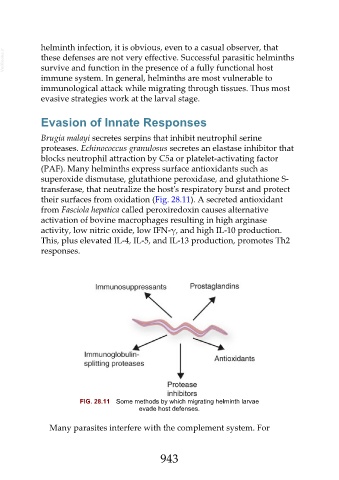Page 943 - Veterinary Immunology, 10th Edition
P. 943
helminth infection, it is obvious, even to a casual observer, that
VetBooks.ir these defenses are not very effective. Successful parasitic helminths
survive and function in the presence of a fully functional host
immune system. In general, helminths are most vulnerable to
immunological attack while migrating through tissues. Thus most
evasive strategies work at the larval stage.
Evasion of Innate Responses
Brugia malayi secretes serpins that inhibit neutrophil serine
proteases. Echinococcus granulosus secretes an elastase inhibitor that
blocks neutrophil attraction by C5a or platelet-activating factor
(PAF). Many helminths express surface antioxidants such as
superoxide dismutase, glutathione peroxidase, and glutathione S-
transferase, that neutralize the host's respiratory burst and protect
their surfaces from oxidation (Fig. 28.11). A secreted antioxidant
from Fasciola hepatica called peroxiredoxin causes alternative
activation of bovine macrophages resulting in high arginase
activity, low nitric oxide, low IFN-γ, and high IL-10 production.
This, plus elevated IL-4, IL-5, and IL-13 production, promotes Th2
responses.
FIG. 28.11 Some methods by which migrating helminth larvae
evade host defenses.
Many parasites interfere with the complement system. For
943

